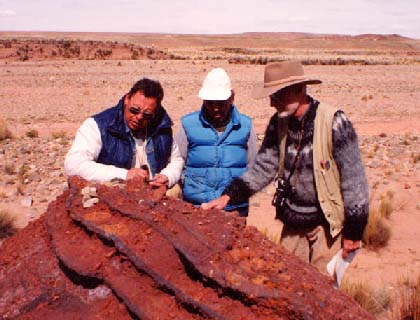
By Dennis P. Cox1, David A. Lindsey2, Donald A. Singer1, Barry C. Moring1, and Michael F. Diggles1
Including:
Descriptive Model of Sediment-Hosted Cu 30b.1 by Dennis P. Cox1
Grade and Tonnage Model of Sediment-Hosted Cu by Dennis P. Cox1 and Donald A. Singer1
Descriptive Model of Reduced-Facies Cu 30b.2 By Dennis P. Cox1
Grade and Tonnage Model of Reduced Facies Cu by Dennis P. Cox1 and Donald A. Singer1
Descriptive Model of Redbed Cu 30b.3, by David A. Lindsey2 and Dennis P. Cox1
Grade and Tonnage Model of Redbed Cu by Dennis P. Cox1 and Donald A. Singer1
Descriptive Model of Revett Cu 30b.4, by Dennis P. Cox1
Grade and Tonnage Model of Revett Cu by Dennis P. Cox1 and Donald A. Singer1
U.S. Geological Survey Open-File Report 03-107
Version 1.3
2003, revised 2007
1 345 Middlefield Road, Menlo Park, CA 94025
2 Box 25046, Denver Federal Center, Denver, CO 80225
Deposit models are based on the descriptions of geologic environments and physical characteristics, and on metal grades and tonnages of many individual deposits. Data used in this study are presented in a database representing 785 deposits in nine continents. This database was derived partly from data published by Kirkham and others (1994) and from new information in recent publications. To facilitate the construction of grade and tonnage models, the information, presented by Kirkham in disaggregated form, was brought together to provide a single grade and a single tonnage for each deposit. Throughout the report individual deposits are defined as being more than 2,000 meters from the nearest adjacent deposit.
The deposit models are presented here as a PDF file. The database can be most conveniently read in FileMaker Pro. For those who do not have the FileMaker application, Microsoft-Excel, tab-delimited-ASCII and comma-separated-value files are included. The reader may be interested in a similar publication on porphyry copper deposits (Singer and others, 2005) also available online.
The Google™ Earth image is not intended to be viewed at the highest possible magnification because the resolution of the database is plus or minus two kilometers. At extreme zoom settings, the deposit locations may not coincide with the Google-Earth images of the mine workings.

Dennis Cox (right) examining a sedimentary copper outcrop near Corocoro, Bolivia with Orlando André and Raul Carrasco. Photograph by June Cox, 1992.

View text for Global Database for Sediment-Hosted Copper Deposits (of03-107.pdf; 2.5 MB).
sed_cu_v1.3.fp5 -- FileMaker-Pro 5 file
sed_cu_v1.3.fp7 -- FileMaker-Pro 7 file
sed_cu_v1.3.txt -- Tab-delimited-ASCII file
sed_cu_v1.3.csv -- Comma-separated-value file
sed_cu_v1.3.xls -- Excel file
sed_cu_v1.3.pdf -- PFD file
View the contents of the data directory (18 MB) and download the files of your choice.
View the plot of the deposit locations. (sed_cu_plot_v1.3.pdf; 4.9 MB).
For questions about the content of this report, contact Dennis Cox
Download a current version of Adobe Reader for free
| Help
| PDF help
| Geopubs main page | Open-File
Reports for 2007 |
|
Privacy Statement | Disclaimer
| Accessibility |
|
Geologic Division | Western Mineral Resources |
A CD-ROM version of the old v. 1.0 of this publication is also available from:
U.S. Geological Survey, Information Services
Box 25286, Federal Center
Denver, CO 80225
Telephone: 1–888–ASK–USGS (1–888–275–8747)
E-mail: infoservices@usgs.gov